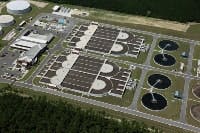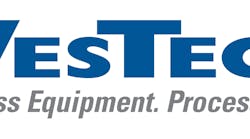The Emerald Coast Utilities Authority (ECUA) manages water and wastewater treatment for Pensacola, Fla., and surrounding areas. The 19-acre Main Street Wastewater Treatment Plant had been in operation since the 1970s and began to require many upgrades.
Located near the beach off of Pensacola Bay, the Main Street Wastewater Treatment Plant was hit by Hurricane Ivan in 2005. When the hurricane struck, it knocked out power to the Main Street Plant for three full days. Some areas of downtown Pensacola were flooded with a combination of storm water, storm surge, and raw sewage.
Equipment Selection
The new Central Water Reclamation Facility site was selected 13 miles away, above the predicted storm surge elevation for a Category 5 hurricane. To reduce capital cost, headworks from the existing Main Street Plant were relocated to the new Central Water Reclamation Facility.
For the heart of the treatment, ECUA and Baskerville Donovan looked to WesTech for design support and equipment supply. WesTech supplied four advanced five-stage biological nutrient removal OxyStream systems and four Clarifier Optimization Packages (COP).
As the goal was to provide for 100% reuse of the treated effluent, the five-stage OxyStream needed to be designed to remove phosphorus and nitrogen to minimum levels.
Following screening and grit removal, the wastewater flows into the first stage of the oxidation ditch—anaerobic selection. This zone allows the influent wastewater and return activated sludge (RAS) to mix together (mixed liquor) without oxygen or nitrate present. This fermentation step is the primary step in the biological phosphorus removal process that promotes increased phosphorus uptake in the aerobic zone, also known as luxury uptake.
The wastewater then flows into the pre-anoxic zone and is combined with the nitrate recycle stream. In the absence of oxygen, nitrogen is removed as gas through the denitrification process.
Following the anaerobic and pre-anoxic stages, the mixed liquor enters the aerobic channels. The mixed liquor is then blended and aerated by slow-speed surface aerators to ensure the complete oxidation of the BOD and ammonia.
Aerator
The most recent advancement to surface aerator technology can be seen in the LANDY-7 impeller. The Landy impellers have always incorporated a sturdy design with zero failures due to cracked, sheared, or broken impeller blades. This new impeller increases oxygen transfer efficiency and reduces axial and radial loads.
The LANDY-7 provides a guaranteed minimum efficiency of 3.8 lb of oxygen per horsepower hour. This improved transfer efficiency saves significant operational costs over the life of the equipment. The reduced axial and radial loads increase the life of the drive unit and reduce the size of support structures and beams for the surface aerators.
This improved efficiency provides significant operational cost savings over the life of the treatment plant.
Following the aeration zone, the mixed liquor flows into the post-anoxic zone. This zone removes any remaining nitrate through endogenous respiration. Finally, the mixed liquor is aerated in the reaeration zone to prevent anoxic or anaerobic conditions in the secondary clarifier that may lead to the secondary release of phosphorus.
After the OxyStream system, the mixed liquor enters the COP clarifiers.
WesTech’s COP clarifiers provide many advantages over conventional clarifiers. Energy Dissipating Inlet (EDI), flocculating feedwell, spiral rake blades, and the sludge withdrawal ring provide optimum clarification and solids removal as well as improved underflow concentrations.
WesTech offers multiple EDI options including traditional scooped gate EDI’s, specialty EDI’s from third party designers, and the company’s Dual-Gate EDI. WesTech’s Dual-Gate EDI gives the flexibility to configure for counter flow, tangential flow, or impinged flow conditions.
WesTech’s spiral rake blades move solids to the center more than four times faster than conventional rake blades. Rapid solids removal is critical when faced with warm liquid temperatures to prevent denitrification and the secondary release of phosphorus.
The sludge withdrawal ring reduces sludge inventory and blanket depth while maintaining high solids concentrations. WesTech’s fixed ring also reduces operations and maintenance hassles by eliminating underwater seals. Following the COP Clarifiers, wastewater is filtered and disinfected prior to distribution to the reuse facilities.
Exceeding Expectations
Through the use of WesTech’s OxyStream and COP package, ECUA is able to meet all treatment objectives and produce high-quality water. The plant is now fully operational and has the ability to treat up to 22.5 million gal per day. The construction of the new wastewater treatment plant allowed the city of Pensacola to provide a zero liquid discharge system, with 100% water reuse.



